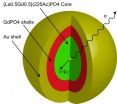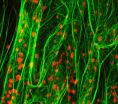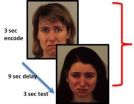(Press-News.org)
VIDEO:
A new discovery might lead to alpha particle therapy for different types of cancer in the near future.
Click here for more information.
COLUMBIA, Mo. ¬— We've all heard that "it's not wise to use a cannon to kill a mosquito." But what if you could focus the cannon's power to concentrate power into a tiny space? In a new study, University of Missouri researchers have demonstrated the ability to harness powerful radioactive particles and direct them toward small cancer tumors while doing negligible damage to healthy organs and tissues. The study is being published this week in PLOS ONE, an international, peer-reviewed and open-access publication.
Typically, when radiation treatment is recommended for cancer patients, doctors are able to choose from several radiopharmaceuticals that use low-energy radiation particles, known as beta particles. For years, scientists have been studying how to use "alpha particles," which are radioactive particles that contain a large amount of energy, in cancer treatments. The challenges to using alpha particles, which are more than 7,000 times heavier than beta particles, include confining the powerful alpha particles in a designated location inside the body while preventing radiation from wandering to healthy organs and tissues.
"If you think of beta particles as slingshots or arrows, alpha particles would be similar to cannon balls," said J. David Robertson, director of research at the MU Research Reactor and professor of chemistry in the College of Arts and Science. "Scientists have had some successes using alpha particles recently, but nothing that can battle different cancers. For example, a current study using radium-223 chloride, which emits alpha particles, has been fast-tracked by the U.S. Food and Drug Administration because it has been shown to be effective in treating bone cancer. However, it only works for bone cancer because the element, radium, is attracted to the bone and stays there. We believe we have found a solution that will allow us to target alpha particles to other cancer sites in the body in an effective manner."
Robertson and researchers from Oak Ridge National Laboratory and the School of Medicine at the University of Tennessee in Knoxville used the element "actinium," which is an element known as an "alpha emitter" because it produces alpha particles. As it decays, actinium creates three additional elements that produce alpha particles. Due to the strength of these particles though, keeping the elements in place at cancer sites was not possible, until Robertson and Mark McLaughlin, MU doctoral student and co-author on the study, designed a gold-plated nanoparticle that serves as a holding cell for the elements, keeping them in place at the cancer site.
Robertson's nanoparticle is a layered device. At the core is the original element, actinium. Robertson's team then added four layers of material and then coated the nanoparticle with gold. This made the nanoparticle strong enough to hold the actinium – and the other alpha emitters that are eventually created – long enough for any alpha particles to destroy nearby cancer cells.
"Holding these alpha emitters in place is a technical challenge that researchers have been trying to overcome for 15 years," Robertson said. "With our nanoparticle design, we are able to keep more than 80 percent of the element inside the nanoparticle 24 hours after it is created."
While alpha particles are extremely powerful, they don't travel very far, so when the nanoparticles get close to cancer cells, the alpha particles move out and destroy the cell much more effectively than current radiation therapy options, Robertson said.
"Previously, basic research had established that scientists can attach antibodies onto gold nanoparticles that help drive the nanoparticles to the tumor sites in the body," Robertson said. "Without that groundbreaking work, we would not have been able to put this puzzle together."
The early-stage results of this research are promising. If additional studies are successful within the next few years, MU officials will request authority from the federal government to begin human drug development (this is commonly referred to as the "investigative new drug" status). After this status has been granted, researchers may conduct human clinical trials with the hope of developing new treatments for cancer.
INFORMATION:
The journal PLOS ONE, is published by PLOS, a non-profit organization committed to making the world's scientific and medical literature a freely available public resource.
MU scientists build harness for powerful radiation cancer therapy
Scientists created a gold nanoparticle that can transport powerful radioactive particles directly to tumors for treatment
2013-02-05
ELSE PRESS RELEASES FROM THIS DATE:
Gene variants found to affect human lifespan
2013-02-05
By broadly comparing the DNA of children to that of elderly people, gene researchers have identified gene variants that influence lifespan, either by raising disease risk or by providing protection from disease.
"This research is the first genome-wide, population-based study of copy number variations in children associated with human longevity," said study leader Hakon Hakonarson, M.D., Ph.D., director of the Center for Applied Genomics at The Children's Hospital of Philadelphia.
The study appeared Jan. 30 in the open-access journal PLOS ONE.
Copy number variations ...
1990s drop in NYC crime not due to CompStat, misdemeanor arrests, study finds
2013-02-05
New York City experienced a historic decline in crime rates during the 1990s, but it was not due to the implementation of CompStat or enhanced enforcement of misdemeanor offenses, according to an analysis by New York University sociologist David Greenberg. The study, which appears in the journal Justice Quarterly, did not find a link between arrests on misdemeanor charges and drops in felonies, such as homicides, robberies, and assaults. In addition, the analysis revealed no significant drop in violent or property crime attributable to the NYPD's introduction of CompStat ...
How plants sense gravity -- a new look at the roles of genetics and the cytoskeleton
2013-02-05
Gravity affects the ecology and evolution of every living organism. In plants, the general response to gravity is well known: their roots respond positively, growing down, into the soil, and their stems respond negatively, growing upward, to reach the sunlight. But how do plants sense gravity and how do they direct or signal their cells to grow in response to it? Although botanists understand a great deal about how this works, a recent article in the recent issue of the American Journal of Botany reviews what we know so far, from mechanical to genetic approaches; it reveals ...
Some cancer mutations slow tumor growth
2013-02-05
CAMBRIDGE, MA -- A typical cancer cell has thousands of mutations scattered throughout its genome and hundreds of mutated genes. However, only a handful of those genes, known as drivers, are responsible for cancerous traits such as uncontrolled growth. Cancer biologists have largely ignored the other mutations, believing they had little or no impact on cancer progression.
But a new study from MIT, Harvard University, the Broad Institute and Brigham and Women's Hospital reveals, for the first time, that these so-called passenger mutations are not just along for the ride. ...
Early breast cancer diagnosis, survival rates low in rural India
2013-02-05
ANN ARBOR—Women in developed countries survive roughly 10 years longer after a breast cancer diagnosis compared to women in poor-to-middle-income countries, a new University of Michigan study suggests.
The report demonstrates the lack of access to good health care faced by women in poor countries, said the study's principal investigator Rajesh Balkrishnan, an associate professor at the U-M schools of Pharmacy and Public Health.
Early diagnosis and sustained treatment were the biggest hurdles and also the main indicators of patient survival, he said.
Balkrishnan and ...
Imaging biomarker predicts response to rapid antidepressant
2013-02-05
VIDEO:
NIMH's Dr. Maura Furey talks about how a functional brain imaging measure may help predict a patient's response to a rapid-acting experimental antidepressant.
Click here for more information.
A telltale boost of activity at the back of the brain while processing emotional information predicted whether depressed patients would respond to an experimental rapid-acting antidepressant, a National Institutes of Health study has found.
"We have discovered a potential ...
Children with autism at significant risk for feeding problems and nutritional deficits
2013-02-05
Healthy eating not only promotes growth and development, but also provides important opportunities for children to socialize during meals. A new, comprehensive analysis of feeding behavior in children with autism spectrum disorders (ASD) indicates that these children are five times more likely to have a feeding problem, including extreme tantrums during meals, severe food selectivity and ritualistic mealtime behaviors.
Researchers at Marcus Autism Center and the Department of Pediatrics at Emory University School of Medicine conducted a comprehensive meta-analysis of ...
NOAA: Tortugas marine reserve yields more, larger fish
2013-02-05
A new NOAA research report finds that both fish populations and commercial and recreational anglers have benefited from "no-take" protections in the Tortugas Ecological Reserve in the Florida Keys National Marine Sanctuary.
The report, "An Integrated Biogeographic Assessment of Reef Fish Populations and Fisheries in Dry Tortugas: Effects of No-take Reserves," is the first to evaluate how the 151-square nautical mile Tortugas Ecological Reserve affects the living marine resources of the region and the people whose livelihoods are connected to them.
The report's analysis ...
Low vitamin D levels may increase risk of Type 1 diabetes
2013-02-05
Boston, MA – Having adequate levels of vitamin D during young adulthood may reduce the risk of adult-onset type 1 diabetes by as much as 50%, according to researchers at Harvard School of Public Health (HSPH). The findings, if confirmed in future studies, could lead to a role for vitamin D supplementation in preventing this serious autoimmune disease in adults. The study was published online February 3, 2013 and will appear in the March 1 print edition of the American Journal of Epidemiology.
"It is surprising that a serious disease such as type 1 diabetes could perhaps ...
Climate change impacts to US coasts threaten public health, safety and economy
2013-02-05
According to a new technical report, the effects of climate change will continue to threaten the health and vitality of U.S. coastal communities' social, economic and natural systems. The report, Coastal Impacts, Adaptation, and Vulnerabilities: a technical input to the 2013 National Climate Assessment, authored by leading scientists and experts, emphasizes the need for increased coordination and planning to ensure U.S. coastal communities are resilient against the effects of climate change.
The recently-released report examines and describes climate change impacts on ...
LAST 30 PRESS RELEASES:
New study sheds light on Milky Way's mysterious chemical history
Could altering the daily timing of immunotherapy improve survival in people with cancer?
Weaving secondary battery electrodes with fibers and tying them like ropes for both durability and performance
Using social media may impair children’s attention
Science briefing: An update on GLP-1 drugs for obesity
Lower doses of immunotherapy for skin cancer give better results
Why didn’t the senior citizen cross the road? Slower crossings may help people with reduced mobility
ASH 2025: Study suggests that a virtual program focusing on diet and exercise can help reduce side effects of lymphoma treatment
A sound defense: Noisy pupae puff away potential predators
Azacitidine–venetoclax combination outperforms standard care in acute myeloid leukemia patients eligible for intensive chemotherapy
Adding epcoritamab to standard second-line therapy improves follicular lymphoma outcomes
New findings support a chemo-free approach for treating Ph+ ALL
Non-covalent btki pirtobrutinib shows promise as frontline therapy for CLL/SLL
University of Cincinnati experts present research at annual hematology event
ASH 2025: Antibody therapy eradicates traces of multiple myeloma in preliminary trial
ASH 2025: AI uncovers how DNA architecture failures trigger blood cancer
ASH 2025: New study shows that patients can safely receive stem cell transplants from mismatched, unrelated donors
Protective regimen allows successful stem cell transplant even without close genetic match between donor and recipient
Continuous and fixed-duration treatments result in similar outcomes for CLL
Measurable residual disease shows strong potential as an early indicator of survival in patients with acute myeloid leukemia
Chemotherapy and radiation are comparable as pre-transplant conditioning for patients with b-acute lymphoblastic leukemia who have no measurable residual disease
Roughly one-third of families with children being treated for leukemia struggle to pay living expenses
Quality improvement project results in increased screening and treatment for iron deficiency in pregnancy
IV iron improves survival, increases hemoglobin in hospitalized patients with iron-deficiency anemia and an acute infection
Black patients with acute myeloid leukemia are younger at diagnosis and experience poorer survival outcomes than White patients
Emergency departments fall short on delivering timely treatment for sickle cell pain
Study shows no clear evidence of harm from hydroxyurea use during pregnancy
Long-term outlook is positive for most after hematopoietic cell transplant for sickle cell disease
Study offers real-world data on commercial implementation of gene therapies for sickle cell disease and beta thalassemia
Early results suggest exa-cel gene therapy works well in children
[Press-News.org] MU scientists build harness for powerful radiation cancer therapyScientists created a gold nanoparticle that can transport powerful radioactive particles directly to tumors for treatment


